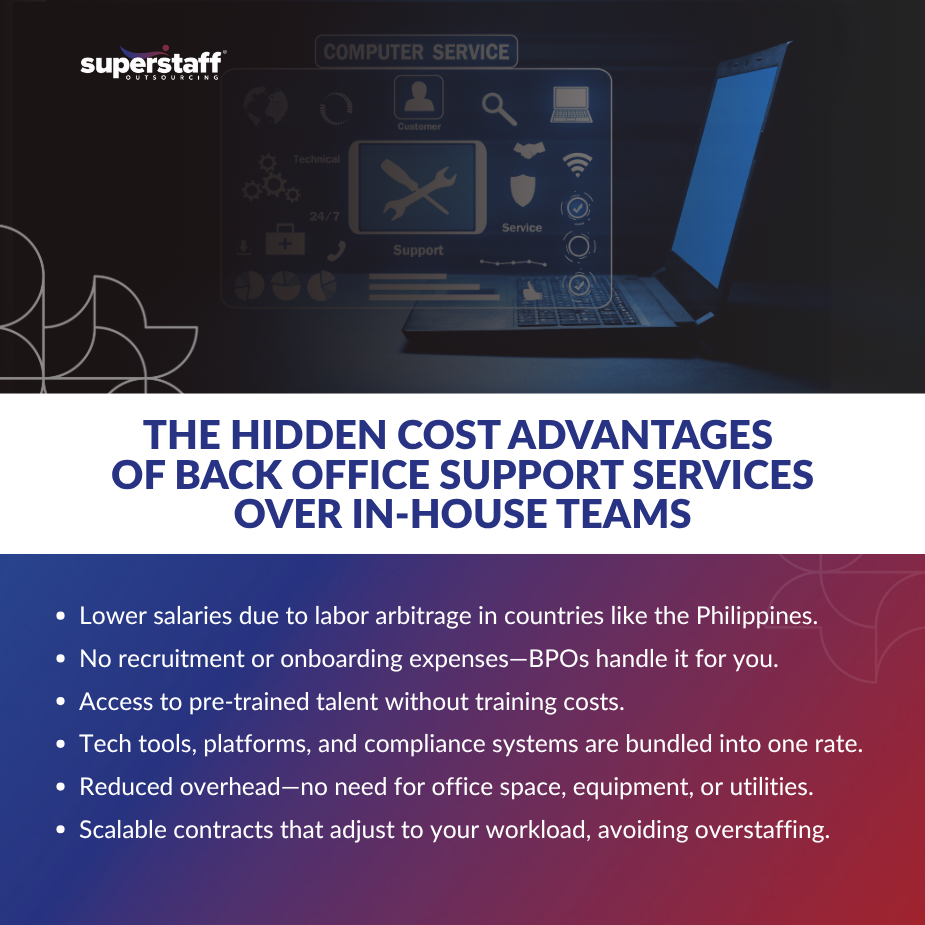
Back-office functions are essential to every business—but because they’re not client-facing or revenue-generating, they’re often the first to face budget cuts. From payroll and accounting to data entry and admin support, these tasks quietly keep operations running. Yet, many companies underestimate how much in-house back-office operations actually cost. Salaries may be easy to track, but what about the recruitment time, employee turnover, IT needs, and compliance risks that come with them?
That’s where the real dilemma begins. While outsourcing back office support services has gained traction in recent years, some leaders remain hesitant—unsure whether the cost savings are truly worth the shift.
This blog unpacks the real numbers. We’ll compare the total cost of running in-house teams versus partnering with an outsourcing provider, shedding light on the hidden, upfront, and long-term financial impacts of each model. If you’re weighing cost efficiency against control, or scalability against proximity, this guide will help you make a clearer, more confident decision.
The Full Cost of In-House Back Office Operations
In-house operations often carry more hidden costs than leaders expect.
At first glance, building an internal back office support services team might seem like the safer and more controllable option. But the financial commitment goes far beyond base salaries. Businesses must consider benefits packages, paid leaves, insurance, and bonuses. These costs can easily push compensation up by 20-30% per employee.
Beyond compensation, recruitment is a major cost center. Hiring the right candidates demands time and resources, from posting ads and screening applicants to conducting interviews and onboarding. And when turnover hits—which is common in transactional roles like data entry or claims processing—the cycle starts all over again.
IT infrastructure adds another layer. From software licensing fees to purchasing hardware and maintaining secure networks, setting up in-house teams to operate efficiently is not cheap. Companies must also budget for cybersecurity measures, regular updates, and compliance audits.
Training and compliance management are often overlooked. Regulations change frequently, and ongoing upskilling is needed to avoid operational or legal pitfalls. In-house teams must be consistently trained, tracked, and certified—all of which eats into both budget and time.
Finally, real estate and operational overhead tie everything together. Office leases, utility bills, equipment, and workplace maintenance can drain budgets fast, especially in high-cost urban centers.
With these hidden costs in mind, outsourcing becomes a more attractive option.
Benefits of Outsourcing Back-Office Services vs. In-House Operations: What You’re Actually Paying For
Back office outsourcing consolidates multiple costs into a predictable, all-in rate.
When companies turn to outsourcing providers for back office support services, they immediately benefit from cost consolidation. Instead of managing a patchwork of line items (salaries, tech, training, HR), clients pay a fixed or scalable fee that covers it all.
The biggest cost lever is labor arbitrage. Offshore BPO hubs like the Philippines or Colombia offer highly educated, English-speaking talent at a fraction of U.S. wages. This makes it possible to staff entire teams for what one in-house hire might cost.
BPOs also bundle in tech platforms and compliance tools. Instead of investing in individual software licenses and setting up your own secure systems, you gain access to enterprise-grade solutions built into the service.
Another significant benefit: You don’t pay for recruitment, onboarding, or training. Most BPOs provide pre-trained professionals or invest in training programs so your business doesn’t have to.
Lastly, outsourced back office support services give you agility. Need to scale up for a busy season? Downsize after a project ends? BPOs offer contractual flexibility, so you’re not stuck with overhead you no longer need.
While outsourcing reduces upfront costs, the savings don’t stop there.

Comparative Case Breakdown – In-House vs. Outsourced (U.S. vs. Philippines)
You’re probably wondering, “How much does back office outsourcing save?” Looking at real-world numbers highlights the stark contrast.
Let’s break it down with a sample role: an Accounts Payable Specialist.
In the U.S., the average salary for this role is around $50,000 per year. Add 25% for benefits, recruitment, and onboarding costs, and you’re closer to $62,500 annually. Now factor in IT, office space, software, training, and management overhead, and the total cost per employee can hit $75,000 or more.
In contrast, outsourcing this same role to a reputable BPO provider in the Philippines could cost between $18,000 to $25,000 annually—all in. That includes recruitment, software access, compliance support, management oversight, and round-the-clock productivity.
Over 12 months, that’s a cost savings of $50,000 per employee. Multiply that across a 10-person team, and your business could save half a million dollars annually—without sacrificing quality.
But beyond savings, there are strategic implications to consider.
Beyond the Dollar Sign – Strategic Advantages of Outsourcing
Outsourcing isn’t just about cutting costs—it’s about gaining operational leverage.
When companies partner with providers of back office support services, they tap into a deeper talent pool with built-in specialization. BPOs often have subject-matter experts in finance, logistics, HR, and compliance who bring valuable insight and efficiency to routine processes.
There’s also the benefit of time zone advantage. Many BPO hubs operate on a 24/7 model, allowing your business to process reports, handle data entry, or manage customer support while your in-house team sleeps. This increases speed, shortens cycles, and adds value to your workflow.
Employee burnout is also less of a threat in outsourced teams. BPO providers manage shifts, workload balance, and HR issues proactively, allowing for healthier team dynamics.
Most importantly, outsourcing provides built-in redundancy. If one team member is unavailable, BPOs have processes in place to ensure continuity. Succession planning, cross-training, and workforce management are part of the service.
Still, there are situations where in-house makes sense—if the model fits.
When In-House Still Has an Edge
Certain roles or industries may benefit from keeping operations internal.
Outsourcing is powerful, but it’s not universal. There are valid reasons why some roles should stay in-house. High-context positions requiring deep institutional knowledge or cultural nuance—like strategy roles, internal communications, or sensitive HR functions—often thrive better with close collaboration and face-to-face interaction.
Compliance can also play a role. If your industry operates in a tightly regulated environment, such as legal, healthcare, or government contracting, local jurisdiction may mandate data handling within borders or limit outsourcing of specific responsibilities.
Another consideration is internal collaboration. When back office support services employees work closely with cross-functional teams, being physically present may speed up decisions or foster greater innovation.
The key is not choosing one over the other—it’s aligning the model to your goals.
Blended Models – How Smart Companies Combine Both
The most cost-efficient companies use a hybrid back-office structure that strategically integrates back office support services with internal oversight.
More businesses are adopting blended models that combine the strategic benefits of in-house oversight with the cost efficiency of outsourcing. For example, a U.S.-based controller may oversee a global finance operation supported by outsourced clerks, analysts, and specialists in the Philippines.
Repeatable, transactional tasks—like data entry, invoice processing, or payroll reporting—are easily delegated to offshore teams. Meanwhile, leadership, planning, and compliance roles remain internal.
This blended structure allows companies to save costs, scale teams based on workload, and maintain operational control without overextending local resources.
Companies in industries like e-commerce, SaaS, and healthcare are already adopting this model to stay competitive, streamline workflows, and tap into the global talent pool available through expert back office support service providers.
Let’s sum up what companies should weigh when comparing the two options.
Scale Smarter With SuperStaff’s Back Office Support Services
Businesses looking to scale efficiently often turn to back office support services to reduce overhead without compromising quality. In-house teams can offer control, but outsourcing provides scalability, savings, and specialization.
When comparing in-house back office operations with outsourced back office support services, the difference isn’t just financial—it’s strategic. In-house roles bring proximity and collaboration. But they also carry hidden costs, slower scalability, and heavier HR burdens.
Outsourcing, on the other hand, consolidates costs, increases agility, and offers access to trained talent with built-in tech and compliance support.
Ultimately, the best path often lies in blending both. Use in-house teams where nuance and proximity matter. Outsource volume-heavy, process-driven tasks to specialists who can deliver faster and more cost-effectively.
Considering outsourcing your back office support services? SuperStaff provides flexible, scalable support built to your budget and business needs. Reach out today to learn how we can help you grow smarter.






